News
Health shock as clinical waste is disposed of dangerously in Lanka’s hospitals
Clinical waste from hospitals throughout Sri Lanka is disposed of dangerously with incinerators running at below optimum levels, ash and hazardous sludge being exposed to scavengers and the elements, and sharps such as scalpels and needles posing widespread risk to humans, a Government audit has found.

Clinical waste stacked at NHSL
The National Audit Office (NAO) examined 17 hospitals in ten districts across seven provinces. It studied the functions of the Central Environmental Authority (CEA), the Health Ministry, and Sisili Hanaro Encare (Pvt) Ltd, a company contracted to manage clinical waste.
Hospitals, medical laboratories and research centres generating hazardous waste need environmental protection licences (EPLs) from the CEA. The creation, collection, transport, storing, clearing, recycling, disposal or erection of facilities for garbage disposal must be under scheduled waste management licences (SWML).
By December last year, there were 1,521 hospitals and medical institutions in the country. But just 281 of them had EPLs while only 50 State and private hospitals or other medical institutions had SWMLs.
Clinical waste includes laboratory cultures, waste from isolation wards, tissues (swabs), materials or equipment that have been in contact with infected patients, human tissues or fluids. There are sharps, including needles and scalpels; biological and anatomical waste including tissues, organs, body parts, blood and body fluids. Also listed are outdated and discharged drugs; and materials and containers contaminated with such wastes.
In the past, clinical waste was largely buried in hospital premises. But rapid growth in the health sector necessitated formal methods, such as incineration.
In 2006, the Health Ministry introduced a national colour code for segregation of hospital waste. Garbage should be separated at points of generation and gathered in bins or bags of specified colours. But none of the hospitals audited by the NAO followed the code correctly.
The Sri Lanka College of Microbiologists’ (SLCM) National Guidelines on Waste Management recommends the use of yellow polythene bags with a minimum thickness of 300 micrometres (µm) for hazardous waste removal. The thickness of black polythene bags for general waste must be a minimum of 200µm.
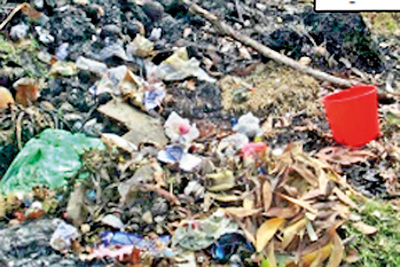
Polluting the environment: Clinical waste at the Badulla hospital
But tests by Sri Lanka Standards Institute at the National Hospital of Sri Lanka (NHSL), the Polonnaruwa District Hospital, the Trincomalee District Hospital, the Peradeniya Teaching Hospital, the Kantale Base Hospital and the Gampaha District Hospital found that thickness ranged from 112 to 79 µm–never the recommended 300 or 200 µm.
The disposal of hazardous waste in substandard bags causes them to tear. Collectors could touch the waste, or it could mix with general waste, thereby entering the environment, the NAO has warned.
Sharps must be placed in puncture-proof and leak-proof cardboard or plastic boxes with a small opening to ensure items don’t drop out, according to the guidelines. They must have yellow covers with red strips and the biohazard symbol.
This was observed widely in the breach. Even the National Hospital of Sri Lanka (NHSL) did not use safety bins, the NAO said. The Kataragama Base Hospital had boxes so large that they could not be put into the incinerator. The contents were removed again from the receptacles before burning.
Waste must be collected regularly from each ward by sanitary workers who wear protective clothing at all times, including face masks, aprons, boots and heavy duty gloves. All yellow bags must be sealed with appropriate adhesive tape and removed from the bins. Sharps boxes must be closed when three-quarter full. Waste should be collected in an easy-to-load-and-clean trolley or cart. It must not be used for any other purpose.
The audited hospitals have disregarded these rules. A spot inspection found that sanitation employees handling clinical waste at NHSL “do not follow any health protective methods whatsoever”. Auditors saw workers packing sharps boxes and hazardous waste without gloves and boots while injuries were observed on their legs.
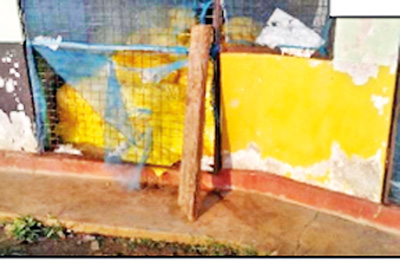
Clinical waste collection at Kantale Hospital
The guidelines prescribe separate central storage facilities for hazardous clinical waste. They must be enclosed and sealed from unauthorised access as well as inaccessible to animals, insects and birds, clean and disinfected with good drainage and ventilation. Refuse must not be kept there for more than 40 hours.
But audited hospitals did not conform. For instance, clinical waste at the Kantale Base Hospital collects for six to nine days before incineration. Refuse was seen falling out of the collection centre which also stank at the time of inspection.
The NHSL collects around 1,200kg of clinical waste daily for which there is inadequate storage. Bags of refuse were seen stacked outside. The storage room had only one door which meant waste was taken out on a “last in, first out” basis. Old waste, therefore, stagnated.
At the Gampaha Hospital, cytotoxic (toxic to living cells) empty bottles — after they were used on cancer patients — and used syringes were scattered around the collection centre. The storage appeared to get wet in the rain, raising the risk of hazardous substances entering the common system.
There were widespread issues with incinerators. In the Gampaha Hospital incinerator, the temperature of the second chamber was observed during a spot check to be lower than the stipulated 1200 degrees Centigrade to minimise emissions of harmful fumes.
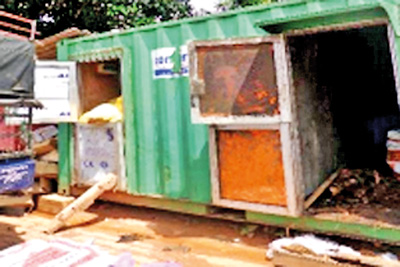
Teaching Hospital Peradeniya
At the Trincomalee District Hospital, where an incinerator was bought in October 2017, audit inspectors found blood scattered near the machine while operators were loading bags of waste into it without wearing protective gear. One employee said they had no storage space for boxes containing sharps.
This incinerator also ran at below the optimum temperature and emitted thick black smoke but the hospital had not conducted requisite tests. Dangerously stored waste was a major environmental issue here, the NAO said. Leftover ash was thrown onto a nearby land.
The Trincomalee Hospital received a MetaMizer in May last year. This equipment uses hybrid autoclave technology to shred and sterilise medical waste. It produces large quantities of sludge which audit inspectors found was not disposed of safely.
At the Polonnaruwa Hospital, which also has a MetaMizer, the sludge was found to contain needles, scalpels and other sharps. This residue was then transferred to its incinerator and destroyed. Workers here said they had no method to dispose of the ash so it was collected in black bags and stacked in the premises. Some were ripped open by animals and their contents scattered around the ground.
At the Tissamaharama Hospital, the incinerator’s chimney was broken and its roof removed so it does not run on rainy days. There is no temperature indicator to verify that it ran at the required heat. Inspectors found that blood discarded after laboratory tests went into gullies which flowed out of the hospital premises. Bags of blood are loaded into the incinerator and allowed to combust.
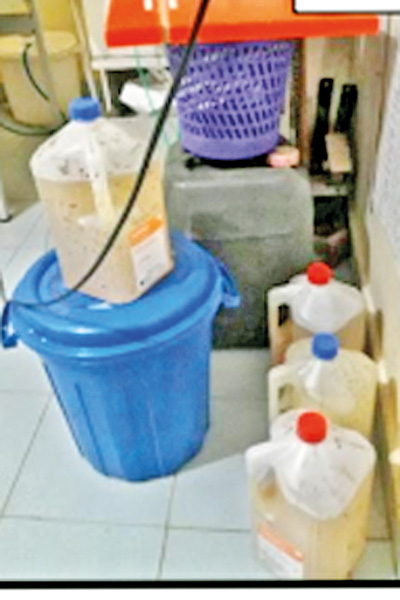
Tissamaharama District Hospital
Inspectors saw large quantities of outdated drugs stacked in the room of sanitary workers. This made it easy for them to remove them from the hospital to dangerous effect, the NAO said. There were also a lot of vials stored in a room. Ash from combustion on a nearby floor and a partly incinerated sample tube could be seen. The burner had no thermometer to test temperature.
Owing to insufficient storage at the Peradeniya Teaching Hospital for clinical waste, it was improperly disposed of in the hospital premises and sometimes set fire to in the open.
The Kataragama Hospital does not even maintain data on its general and clinical waste, the NAO noted. The sharps burner belongs to the office of the Medical Officer of Health (MOH) and is substandard. There is no avenue for ash disposal. Much of the hospital waste, including polythene, is burned in the open, despite there being a preschool nearby. Placenta is buried in an unsafe place and vials have accumulated in a room.
The Kurunegala General Hospital is the country’s third largest and around 2,500 kg of clinical waste is collected daily for incineration and for its MetaMizer. But the incinerator is around 15 years old and is frequently broken, does not properly combust waste and is not operated to maximum capacity, resulting in accumulation.
The Thalassaemia and children’s wards are near the incinerator while a new maternity ward is being built at a higher elevation to the incinerator, making exposure to fumes inevitable. Worse, it emits thick black smoke when chemical waste is being combusted. This was flagged by the hospital’s microbiologist who wrote to the director saying the emissions indicated that waste was not incinerated as required. This incinerator’s temperature indicator was also broken.
Bundles of clinical waste were stacked in the Matara Hospital premises near its waste water treatment plant. Many bags were torn open by scavengers and solid waste scattered around. There was risk of pathogens entering the Nilwala River and the surroundings with rain.
All clinical waste from the Prison Hospital in burned in the open. Hazardous clinical waste from the Nuwara Eliya District Hospital is taken daily by the Urban Council and disposed of in the Sandatenne area without “any basic treatment whatsoever”.
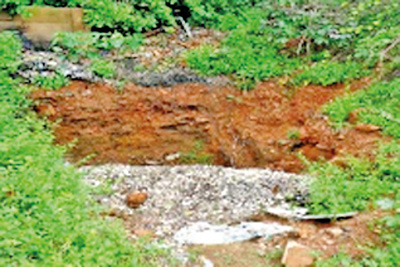
Ash dumped at Trincomalee hospital

